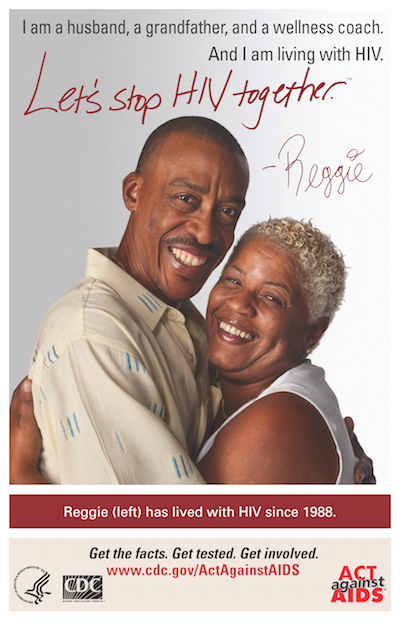Spotlight on HIV and Aging
Topics

Next week, the 2015 White House Conference on Aging puts a spotlight on healthy aging. Held each decade since the 1960s, the conference brings together older Americans, caregivers, government officials, and business and community leaders to discuss a vision for healthy aging in the next decade. For many of us, that vision includes healthy aging, support, and security for older Americans living with HIV, especially given that people aged 50 and older accounted for 40% (or 374,613) of the estimated 933,996 people living with diagnosed HIV infection in the United States in 2012. Thus, it is an opportune moment to highlight some of the many activities underway across the federal government addressing HIV and aging.
As the conference organizers observe, Americans are living longer and better than ever before due to major advances in medicine and public health as well as improved access to health care. This is also true of people living with HIV. Thanks to improvements in HIV treatment over the past two decades, if a young person today is diagnosed with HIV early and begins and remains on treatment, he or she can expect to live a nearly normal lifespan. Because of this, an increasing number of adults with HIV are aging. At the same time, the ranks of older Americans living with HIV are growing because new HIV infections continue to occur among individuals over 50 years old. In 2013, an estimated 18% (8,575) of all new HIV diagnoses were among Americans aged 50 and older, according to CDC.
Individuals living with prolonged HIV infection exhibit many clinical characteristics commonly observed in aging: multiple chronic diseases or conditions, the use of multiple medications, changes in physical and cognitive abilities, and increased vulnerability to stressors. While effective HIV treatments have decreased the likelihood of AIDS-defining illnesses among people aging with HIV, HIV-associated non-AIDS conditions are more common in individuals with long-standing HIV infection. These conditions include cardiovascular disease, lung disease, certain cancers, HIV-Associated Neurocognitive Disorders (HAND), and liver disease (including hepatitis B and hepatitis C), among others.
Addressing the issues associated with HIV and aging are important priorities of federal HIV research, care, and prevention activities.
People Over 50 Fare Well in Ryan White Program
The Ryan White HIV/AIDS Program provides HIV-related services in the United States for those who do not have sufficient health care coverage or financial resources for coping with HIV disease, filling gaps in care not met by other payers. In 2013, 32% (or 199,407) of Ryan White HIV/AIDS Program clients were over the age of 50.
Individuals aged 50 and older in the Ryan White HIV/AIDS Program experience better outcomes along the HIV care continuum than Ryan White clients in general. For example, according to data from HRSA’s HIV/AIDS Bureau (HRSA/HAB), which administers the Ryan White Program, 83.7% of Ryan White clients aged 50 and over were retained in HIV care in 2013, compared to 81% of the Ryan White population in general. Viral suppression rates were even better, with 85% of those aged 50 and over achieving a suppressed viral load, compared to 78.6% of the Ryan White population in general.
HRSA/HAB works with its grantees and technical assistance network to sustain and improve these rates. For example, HRSA/HAB’s AIDS Education and Training CentersExit Disclaimer (AETC) included information on HIV and aging in 16% percent of training events conducted for Ryan White grantees during the most recent reporting year. The AETC network has also established an HIV and Aging Workgroup that recently debuted an HIV and Aging toolkitExit Disclaimer for HIV healthcare professionals. HRSA has also released a newsletter on HAND, a condition associated with aging, but which also can occur in younger people with HIV. Finally, the HRSA TARGET Center contains a myriad of publications around HIV and agingExit Disclaimer to help inform the broader Ryan White community. (Read more about the Ryan White HIV/AIDS Program and Older Adults in this fact sheet).
HIV and Aging: Cross-cutting Research at NIH
The subject of HIV and aging is a major priority in the NIH Office of AIDS Research (OAR). Indeed, there are more than 200 NIH-supported research projects currently underway related to aspects of HIV and aging, sometimes as the main focus of the study and other times as part of a multi-component study.
In 2011, OAR commissioned a working group comprised of experts in both HIV/AIDS and geriatrics, as well as representatives from the HIV affected community to develop an outline of the current state of knowledge and identify high priority research opportunities in HIV and aging. The working groups' findings and recommendations were summarized in this 2012 report and continue to inform NIH’s HIV/AIDS research activities.
Among the many current NIH research activities related to HIV and aging are:
- The REPRIEVE (Randomized Trial to Prevent Vascular Events in HIV) study launched in June 2015 will address scientific questions that are of high relevance to aging HIV-positive individuals. The trial will establish if using a daily statin (Pitavastatin) can prevent or reduce the risk for major adverse cardiovascular events in people with HIV.
- NIH’s National Institute on Aging is supporting a number of studies on the pathology, prevention, treatment, and management of HIV in older individuals. These include studies of impairments in various organs and organ systems in the context of HIV infection with advancing age, as well as studies of the role of social support networks in maintaining the health of older persons living with HIV.
- The network of 20 NIH-supported Centers for AIDS Research (CFARs) have organized an Inter-CFAR working group on aging to plan and support interdisciplinary research on HIV and aging within their network.
- NIH also recently released a renewed Funding Opportunity Announcement for Multidisciplinary Studies of HIV/AIDS and Aging, involving 11 NIH Institutes and Centers. The currently open announcement invites applications proposing to study a variety of factors associated with HIV/AIDS in the context of aging and/or in older adults. In addition, earlier this year OAR in collaboration with 9 NIH Institutes and Centers announced the availability of $2 million in funding supplements to expand the scope of HIV and aging research by supporting promising leads identified in ongoing studies.
Findings from these and many other NIH-supported research activities will continue to inform and improve our understanding of and approaches to HIV prevention, care and treatment across the lifespan.
Prevention Challenges: New HIV Infections among People Over 50 Years Old
HIV prevention efforts for older adults remain important. Many older people are sexually active, and have many of the same risk factors for HIV infection as younger people, including a lack of knowledge about HIV and how to prevent it, and exposure to multiple sexual partners. As CDC observes, older people also face some unique risk factors, including:
- Many widowed and divorced people are dating again, and they may be less knowledgeable about HIV than younger people, and less likely to protect themselves.
- Women who no longer worry about getting pregnant may be less likely to use a condom and to practice safer sex. Age-related thinning and dryness of vaginal tissue may raise older women’s risk for becoming infected if exposed to the virus.
- The availability of erectile dysfunction medications may facilitate sex for older men who otherwise would not have been capable of exposure via vaginal or anal intercourse.
- Although they visit their doctors more frequently, older people are less likely than younger people to discuss their sexual habits or drug use with their doctors, who in turn may be less likely to ask their older patients about these issues—assuming, incorrectly, that their older patients are not sexually active
Many older adults have insufficient information about HIV transmission and may harbor inaccurate perceptions about their risk for infection; this reality underscores the importance of the National HIV/AIDS Strategy’s call for broader HIV education across the lifespan—including among older Americans.

To address HIV prevention among older Americans as well as promote the effectiveness of HIV treatment and combat HIV-related stigma, several of CDC’s Act Against AIDS has been one of the national partners in the Act Against AIDS Leadership Initiative.
This post provides a small sampling of the many HIV activities focused on older persons that are underway across the U.S. Department of Health and Human Services (HHS). Our work in this domain must continue to grow and will remain an essential component of a comprehensive response to HIV/AIDS in America.
For more information on HIV and aging, visit HIV.gov’s pages:
And follow NIH’s National Library of Medicine’s Twitter account @NLM_HIVplus50Exit Disclaimer